2009 NISSAN VERSA HATCHBACK mileage
[x] Cancel search: mileagePage 29 of 55
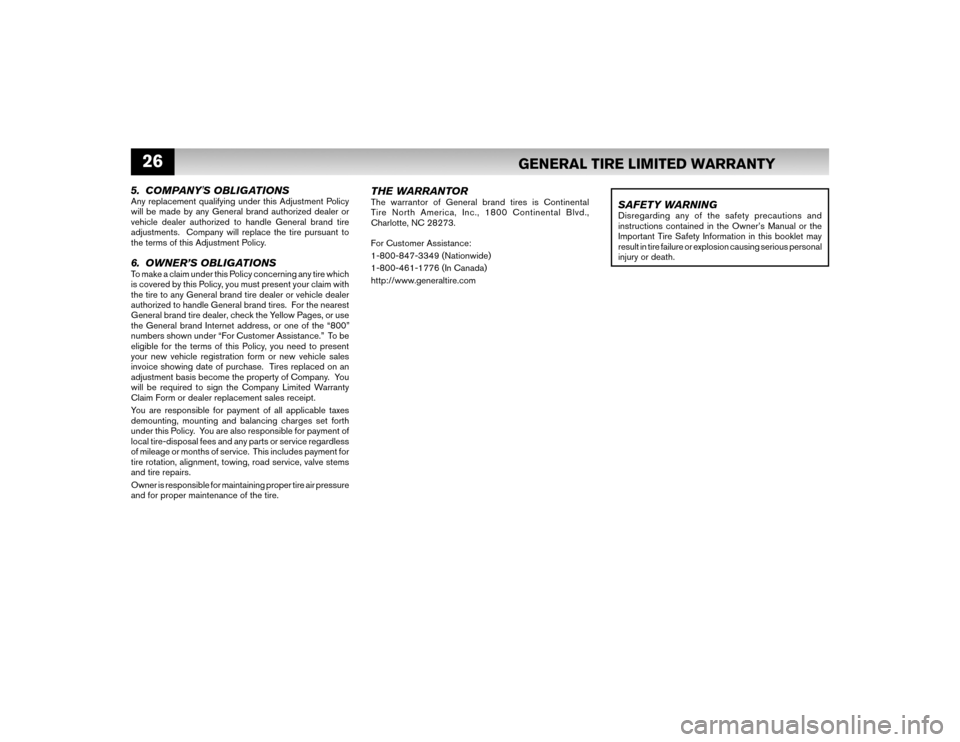
26
GENERAL TIRE LIMITED WARRANTY
5. COMPANY'S OBLIGATIONSAny replacement qualifying under this Adjustment Policy
will be made by any General brand authorized dealer or
vehicle dealer authorized to handle General brand tire
adjustments. Company will replace the tire pursuant to
the terms of this Adjustment Policy.6. OWNER’S OBLIGATIONSTo make a claim under this Policy concerning any tire which
is covered by this Policy, you must present your claim with
the tire to any General brand tire dealer or vehicle dealer
authorized to handle General brand tires. For the nearest
General brand tire dealer, check the Yellow Pages, or use
the General brand Internet address, or one of the “800”
numbers shown under “For Customer Assistance.” To be
eligible for the terms of this Policy, you need to present
your new vehicle registration form or new vehicle sales
invoice showing date of purchase. Tires replaced on an
adjustment basis become the property of Company. You
will be required to sign the Company Limited Warranty
Claim Form or dealer replacement sales receipt.
You are responsible for payment of all applicable taxes
demounting, mounting and balancing charges set forth
under this Policy. You are also responsible for payment of
local tire-disposal fees and any parts or service regardless
of mileage or months of service. This includes payment for
tire rotation, alignment, towing, road service, valve stems
and tire repairs.
Owner is responsible for maintaining proper tire air pressure
and for proper maintenance of the tire.
THE WARRANTORThe warrantor of General brand tires is Continental
Tire North America, Inc., 1800 Continental Blvd.,
Charlotte, NC 28273.
For Customer Assistance:
1-800-847-3349 (Nationwide)
1-800-461-1776 (In Canada)
http://www.generaltire.com
SAFETY WARNINGDisregarding any of the safety precautions and
instructions contained in the Owner’s Manual or the
Important Tire Safety Information in this booklet may
result in tire failure or explosion causing serious personal
injury or death.
Page 33 of 55
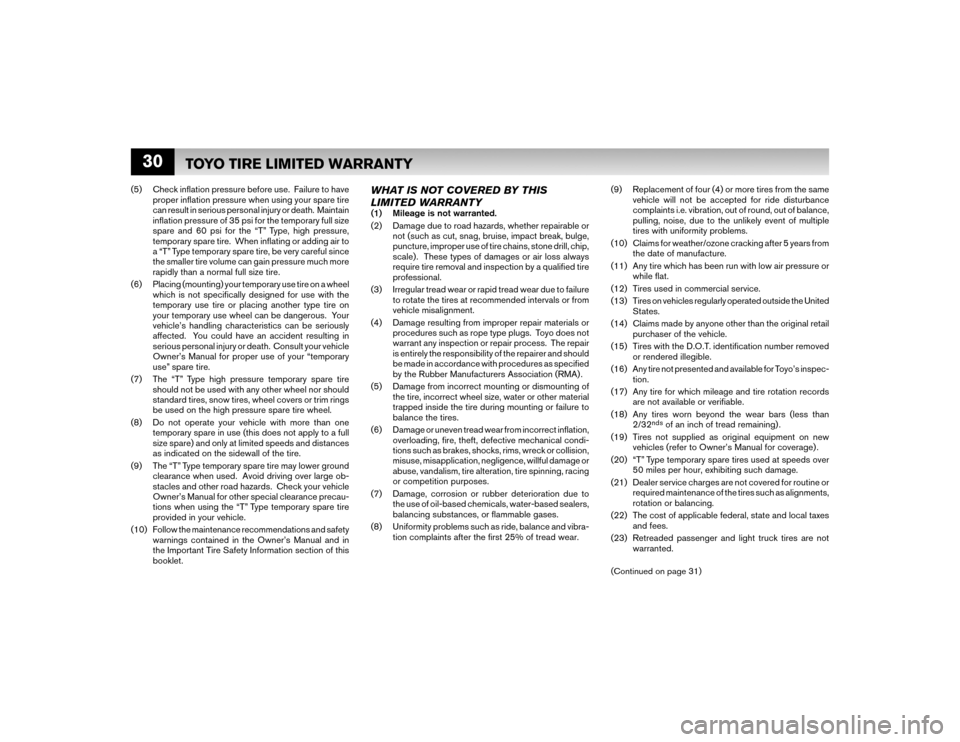
30
(9) Replacement of four (4) or more tires from the same
vehicle will not be accepted for ride disturbance
complaints i.e. vibration, out of round, out of balance,
pulling, noise, due to the unlikely event of multiple
tires with uniformity problems.
(10) Claims for weather/ozone cracking after 5 years from
the date of manufacture.
(11) Any tire which has been run with low air pressure or
while fl at.
(12) Tires used in commercial service.
(13) Tires on vehicles regularly operated outside the United
States.
(14) Claims made by anyone other than the original retail
purchaser of the vehicle.
(15) Tires with the D.O.T. identifi cation number removed
or rendered illegible.
(16) Any tire not presented and available for Toyo’s inspec-
tion.
(17) Any tire for which mileage and tire rotation records
are not available or verifi able.
(18) Any tires worn beyond the wear bars (less than
2/32
nds of an inch of tread remaining) .
(19) Tires not supplied as original equipment on new
vehicles (refer to Owner’s Manual for coverage) .
(20) “T” Type temporary spare tires used at speeds over
50 miles per hour, exhibiting such damage.
(21) Dealer service charges are not covered for routine or
required maintenance of the tires such as alignments,
rotation or balancing.
(22) The cost of applicable federal, state and local taxes
and fees.
(23) Retreaded passenger and light truck tires are not
warranted.
TOYO TIRE LIMITED WARRANTY
(5) Check infl ation pressure before use. Failure to have
proper infl ation pressure when using your spare tire
can result in serious personal injury or death. Maintain
infl ation pressure of 35 psi for the temporary full size
spare and 60 psi for the “T” Type, high pressure,
temporary spare tire. When infl ating or adding air to
a “T” Type temporary spare tire, be very careful since
the smaller tire volume can gain pressure much more
rapidly than a normal full size tire.
(6) Placing (mounting) your temporary use tire on a wheel
which is not specifi cally designed for use with the
temporary use tire or placing another type tire on
your temporary use wheel can be dangerous. Your
vehicle’s handling characteristics can be seriously
affected. You could have an accident resulting in
serious personal injury or death. Consult your vehicle
Owner’s Manual for proper use of your “temporary
use” spare tire.
(7) The “T” Type high pressure temporary spare tire
should not be used with any other wheel nor should
standard tires, snow tires, wheel covers or trim rings
be used on the high pressure spare tire wheel.
(8) Do not operate your vehicle with more than one
temporary spare in use (this does not apply to a full
size spare) and only at limited speeds and distances
as indicated on the sidewall of the tire.
(9) The “T” Type temporary spare tire may lower ground
clearance when used. Avoid driving over large ob-
stacles and other road hazards. Check your vehicle
Owner’s Manual for other special clearance precau-
tions when using the “T” Type temporary spare tire
provided in your vehicle.
(10) Follow the maintenance recommendations and safety
warnings contained in the Owner’s Manual and in
the Important Tire Safety Information section of this
booklet.
WHAT IS NOT COVERED BY THIS
LIMITED WARRANTY(1) Mileage is not warranted.
(2) Damage due to road hazards, whether repairable or
not (such as cut, snag, bruise, impact break, bulge,
puncture, improper use of tire chains, stone drill, chip,
scale) . These types of damages or air loss always
require tire removal and inspection by a qualifi ed tire
professional.
(3) Irregular tread wear or rapid tread wear due to failure
to rotate the tires at recommended intervals or from
vehicle misalignment.
(4) Damage resulting from improper repair materials or
procedures such as rope type plugs. Toyo does not
warrant any inspection or repair process. The repair
is entirely the responsibility of the repairer and should
be made in accordance with procedures as specifi ed
by the Rubber Manufacturers Association (RMA) .
(5) Damage from incorrect mounting or dismounting of
the tire, incorrect wheel size, water or other material
trapped inside the tire during mounting or failure to
balance the tires.
(6) Damage or uneven tread wear from incorrect infl ation,
overloading, fi re, theft, defective mechanical condi-
tions such as brakes, shocks, rims, wreck or collision,
misuse, misapplication, negligence, willful damage or
abuse, vandalism, tire alteration, tire spinning, racing
or competition purposes.
(7) Damage, corrosion or rubber deterioration due to
the use of oil-based chemicals, water-based sealers,
balancing substances, or fl ammable gases.
(8) Uniformity problems such as ride, balance and vibra-
tion complaints after the fi rst 25% of tread wear.
(Continued on page 31)
Page 38 of 55
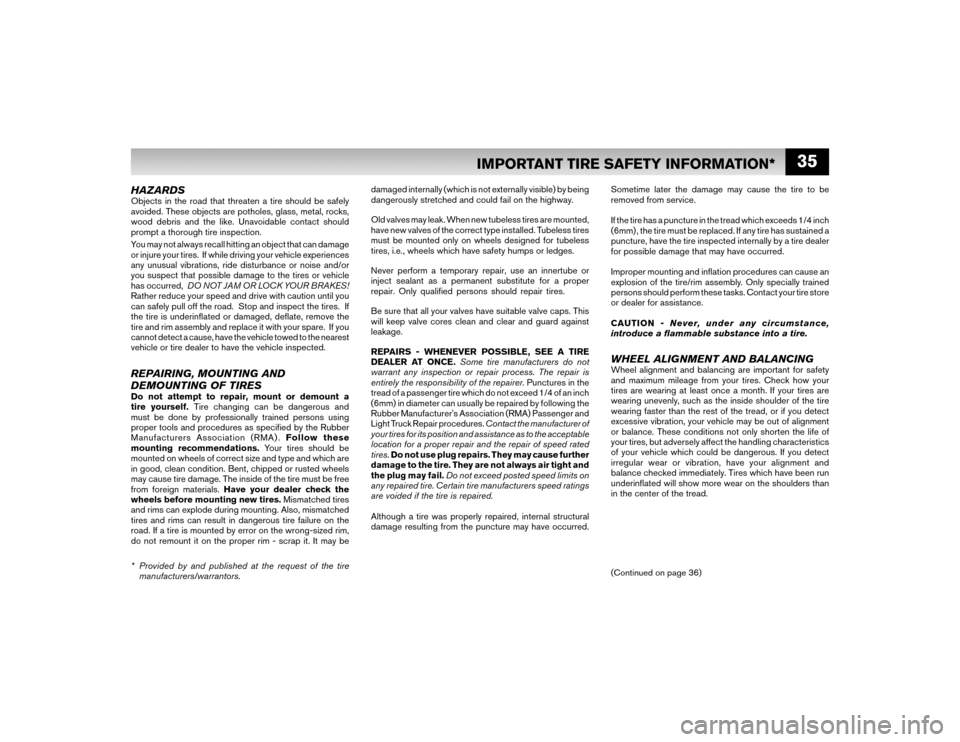
35
HAZARDSObjects in the road that threaten a tire should be safely
avoided. These objects are potholes, glass, metal, rocks,
wood debris and the like. Unavoidable contact should
prompt a thorough tire inspection.
You may not always recall hitting an object that can damage
or injure your tires. If while driving your vehicle experiences
any unusual vibrations, ride disturbance or noise and/or
you suspect that possible damage to the tires or vehicle
has occurred, DO NOT JAM OR LOCK YOUR BRAKES!
Rather reduce your speed and drive with caution until you
can safely pull off the road. Stop and inspect the tires. If
the tire is underinfl ated or damaged, defl ate, remove the
tire and rim assembly and replace it with your spare. If you
cannot detect a cause, have the vehicle towed to the nearest
vehicle or tire dealer to have the vehicle inspected.REPAIRING, MOUNTING AND
DEMOUNTING OF TIRESDo not attempt to repair, mount or demount a
tire yourself. Tire changing can be dangerous and
must be done by professionally trained persons using
proper tools and procedures as specifi ed by the Rubber
Manufacturers Association (RMA) . Follow these
mounting recommendations. Your tires should be
mounted on wheels of correct size and type and which are
in good, clean condition. Bent, chipped or rusted wheels
may cause tire damage. The inside of the tire must be free
from foreign materials. Have your dealer check the
wheels before mounting new tires. Mismatched tires
and rims can explode during mounting. Also, mismatched
tires and rims can result in dangerous tire failure on the
road. If a tire is mounted by error on the wrong-sized rim,
do not remount it on the proper rim - scrap it. It may be damaged internally (which is not externally visible) by being
dangerously stretched and could fail on the highway.
Old valves may leak. When new tubeless tires are mounted,
have new valves of the correct type installed. Tubeless tires
must be mounted only on wheels designed for tubeless
tires, i.e., wheels which have safety humps or ledges.
Never perform a temporary repair, use an innertube or
inject sealant as a permanent substitute for a proper
repair. Only qualifi ed persons should repair tires.
Be sure that all your valves have suitable valve caps. This
will keep valve cores clean and clear and guard against
leakage.
REPAIRS - WHENEVER POSSIBLE, SEE A TIRE
DEALER AT ONCE. Some tire manufacturers do not
warrant any inspection or repair process. The repair is
entirely the responsibility of the repairer. Punctures in the
tread of a passenger tire which do not exceed 1/4 of an inch
(6mm) in diameter can usually be repaired by following the
Rubber Manufacturer's Association (RMA) Passenger and
Light Truck Repair procedures. Contact the manufacturer of
your tires for its position and assistance as to the acceptable
location for a proper repair and the repair of speed rated
tires. Do not use plug repairs. They may cause further
damage to the tire. They are not always air tight and
the plug may fail. Do not exceed posted speed limits on
any repaired tire. Certain tire manufacturers speed ratings
are voided if the tire is repaired.
Although a tire was properly repaired, internal structural
damage resulting from the puncture may have occurred. Sometime later the damage may cause the tire to be
removed from service.
If the tire has a puncture in the tread which exceeds 1/4 inch
(6mm) , the tire must be replaced. If any tire has sustained a
puncture, have the tire inspected internally by a tire dealer
for possible damage that may have occurred.
Improper mounting and infl ation procedures can cause an
explosion of the tire/rim assembly. Only specially trained
persons should perform these tasks. Contact your tire store
or dealer for assistance.
CAUTION - Never, under any circumstance,
introduce a fl ammable substance into a tire.
WHEEL ALIGNMENT AND BALANCINGWheel alignment and balancing are important for safety
and maximum mileage from your tires. Check how your
tires are wearing at least once a month. If your tires are
wearing unevenly, such as the inside shoulder of the tire
wearing faster than the rest of the tread, or if you detect
excessive vibration, your vehicle may be out of alignment
or balance. These conditions not only shorten the life of
your tires, but adversely affect the handling characteristics
of your vehicle which could be dangerous. If you detect
irregular wear or vibration, have your alignment and
balance checked immediately. Tires which have been run
underinfl ated will show more wear on the shoulders than
in the center of the tread.
* Provided by and published at the request of the tire
manufacturers/warrantors.
IMPORTANT TIRE SAFETY INFORMATION*
(Continued on page 36)
Page 40 of 55
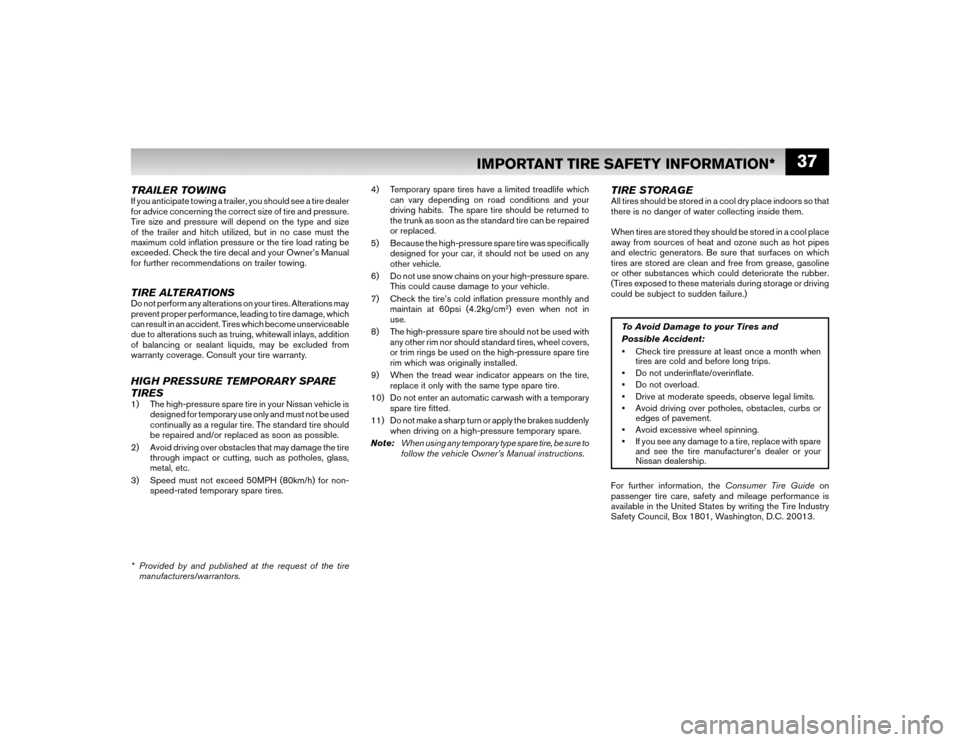
37
TRAILER TOWINGIf you anticipate towing a trailer, you should see a tire dealer
for advice concerning the correct size of tire and pressure.
Tire size and pressure will depend on the type and size
of the trailer and hitch utilized, but in no case must the
maximum cold infl ation pressure or the tire load rating be
exceeded. Check the tire decal and your Owner’s Manual
for further recommendations on trailer towing.TIRE ALTERATIONSDo not perform any alterations on your tires. Alterations may
prevent proper performance, leading to tire damage, which
can result in an accident. Tires which become unserviceable
due to alterations such as truing, whitewall inlays, addition
of balancing or sealant liquids, may be excluded from
warranty coverage. Consult your tire warranty.HIGH PRESSURE TEMPORARY SPARE
TIRES1) The high-pressure spare tire in your Nissan vehicle is
designed for temporary use only and must not be used
continually as a regular tire. The standard tire should
be repaired and/or replaced as soon as possible.
2) Avoid driving over obstacles that may damage the tire
through impact or cutting, such as potholes, glass,
metal, etc.
3) Speed must not exceed 50MPH (80km/h) for non-
speed-rated temporary spare tires.4) Temporary spare tires have a limited treadlife which
can vary depending on road conditions and your
driving habits. The spare tire should be returned to
the trunk as soon as the standard tire can be repaired
or replaced.
5) Because the high-pressure spare tire was specifi cally
designed for your car, it should not be used on any
other vehicle.
6) Do not use snow chains on your high-pressure spare.
This could cause damage to your vehicle.
7) Check the tire’s cold infl ation pressure monthly and
maintain at 60psi (4.2kg/cm
2) even when not in
use.
8) The high-pressure spare tire should not be used with
any other rim nor should standard tires, wheel covers,
or trim rings be used on the high-pressure spare tire
rim which was originally installed.
9) When the tread wear indicator appears on the tire,
replace it only with the same type spare tire.
10) Do not enter an automatic carwash with a temporary
spare tire fi tted.
11) Do not make a sharp turn or apply the brakes suddenly
when driving on a high-pressure temporary spare.
Note: When using any temporary type spare tire, be sure to
follow the vehicle Owner’s Manual instructions.
TIRE STORAGEAll tires should be stored in a cool dry place indoors so that
there is no danger of water collecting inside them.
When tires are stored they should be stored in a cool place
away from sources of heat and ozone such as hot pipes
and electric generators. Be sure that surfaces on which
tires are stored are clean and free from grease, gasoline
or other substances which could deteriorate the rubber.
(Tires exposed to these materials during storage or driving
could be subject to sudden failure.)
To Avoid Damage to your Tires and
Possible Accident:
• Check tire pressure at least once a month when
tires are cold and before long trips.
• Do not underinfl ate/overinfl ate.
• Do not overload.
• Drive at moderate speeds, observe legal limits.
• Avoid driving over potholes, obstacles, curbs or
edges of pavement.
• Avoid excessive wheel spinning.
• If you see any damage to a tire, replace with spare
and see the tire manufacturer’s dealer or your
Nissan dealership.
For further information, the Consumer Tire Guide on
passenger tire care, safety and mileage performance is
available in the United States by writing the Tire Industry
Safety Council, Box 1801, Washington, D.C. 20013.
* Provided by and published at the request of the tire
manufacturers/warrantors.
IMPORTANT TIRE SAFETY INFORMATION*
Page 49 of 55
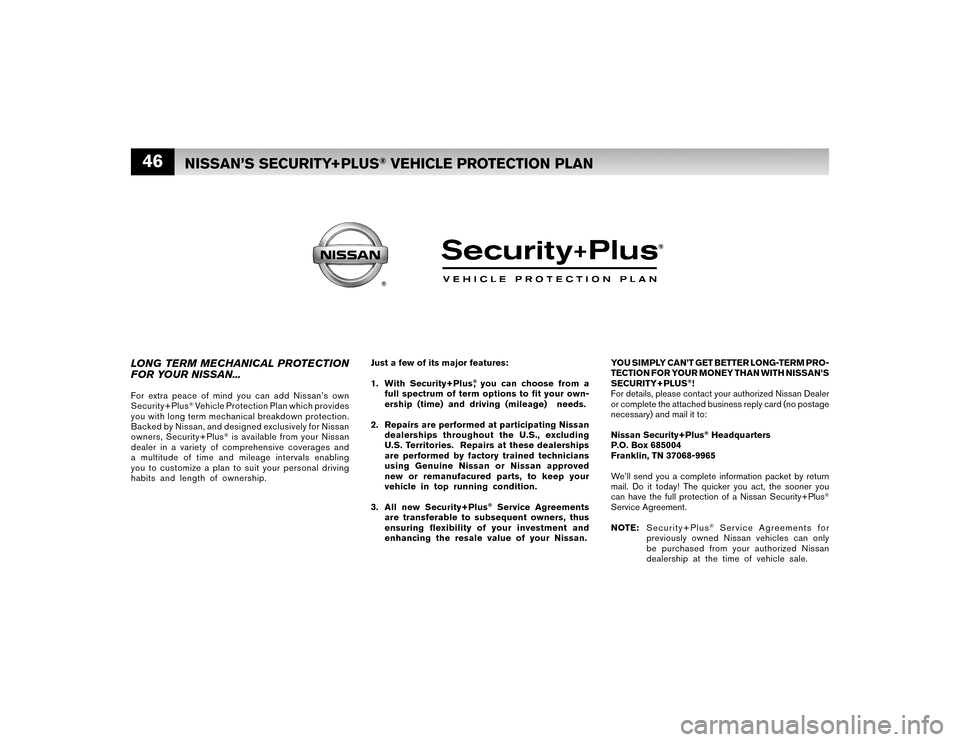
46
YOU SIMPLY CAN’T GET BETTER LONG-TERM PRO-
TECTION FOR YOUR MONEY THAN WITH NISSAN’S
SECURITY+PLUS
®!
For details, please contact your authorized Nissan Dealer
or complete the attached business reply card (no postage
necessary) and mail it to:
Nissan Security+Plus
® Headquarters
P.O. Box 685004
Franklin, TN 37068-9965
We’ll send you a complete information packet by return
mail. Do it today! The quicker you act, the sooner you
can have the full protection of a Nissan Security+Plus
®
Service Agreement.
NOTE: Security+Plus
® Service Agreements for
previously owned Nissan vehicles can only
be purchased from your authorized Nissan
dealership at the time of vehicle sale. Just a few of its major features:
1. With Security+Plus
®, you can choose from a
full spectrum of term options to fi t your own-
ership (time) and driving (mileage) needs.
2. Repairs are performed at participating Nissan
dealerships throughout the U.S., excluding
U.S. Territories. Repairs at these dealerships
are performed by factory trained technicians
using Genuine Nissan or Nissan approved
new or remanufacured parts, to keep your
vehicle in top running condition.
3. All new Security+Plus
® Service Agreements
are transferable to subsequent owners, thus
ensuring fl exibility of your investment and
enhancing the resale value of your Nissan.
LONG TERM MECHANICAL PROTECTION
FOR YOUR NISSAN...For extra peace of mind you can add Nissan’s own
Security+Plus
® Vehicle Protection Plan which provides
you with long term mechanical breakdown protection.
Backed by Nissan, and designed exclusively for Nissan
owners, Security+Plus
® is available from your Nissan
dealer in a variety of comprehensive coverages and
a multitude of time and mileage intervals enabling
you to customize a plan to suit your personal driving
habits and length of ownership.
NISSAN’S SECURITY+PLUS
® VEHICLE PROTECTION PLAN
Page 54 of 55
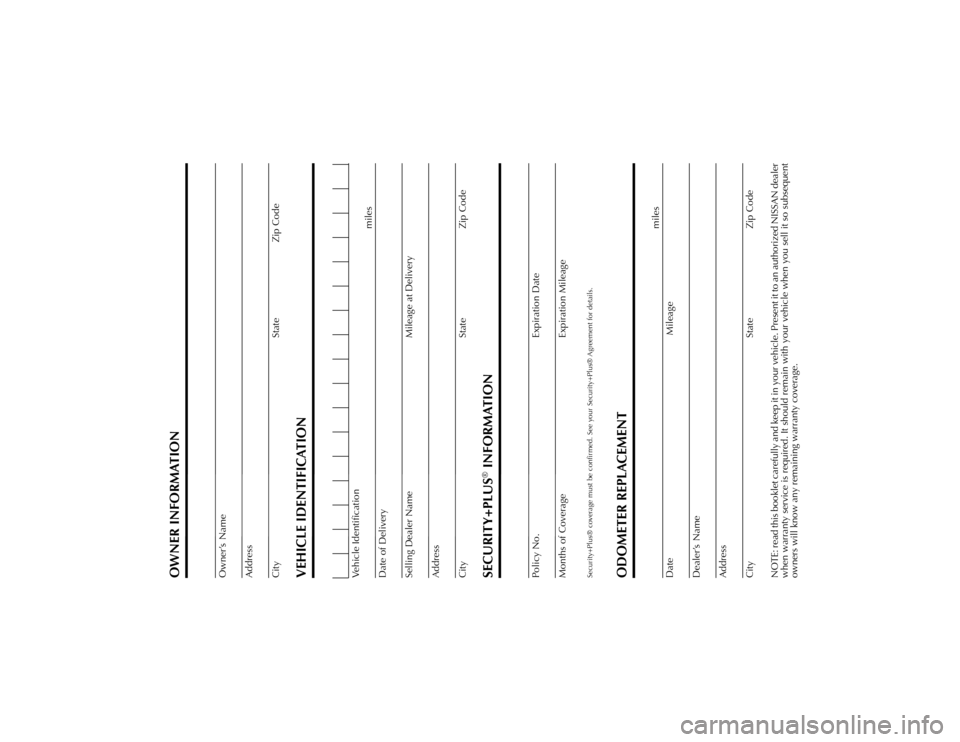
OWNER INFORMATION
Owner’s Name
Address
City State Zip Code
VEHICLE IDENTIFICATION
Vehicle Identification
Date of Deliverymiles
Selling Dealer NameMileage at Delivery
Address
City State Zip Code
SECURITY+PLUS® INFORMATION
Policy No. Expiration Date
Months of CoverageExpiration Mileage
Security+Plus® coverage must be confirmed. See your Security+Plus® Agreement for details.
ODOMETER REPLACEMENT
Date Mileagemiles
Dealer’s Name
Address
City State Zip Code
NOTE: read this booklet carefully and keep it in your vehicle. Present it to an authorized NISSAN dealer
when warranty service is required. It should remain with your vehicle when you sell it so subsequent
owners will know any remaining warranty coverage.